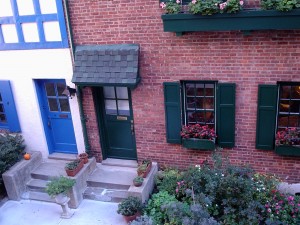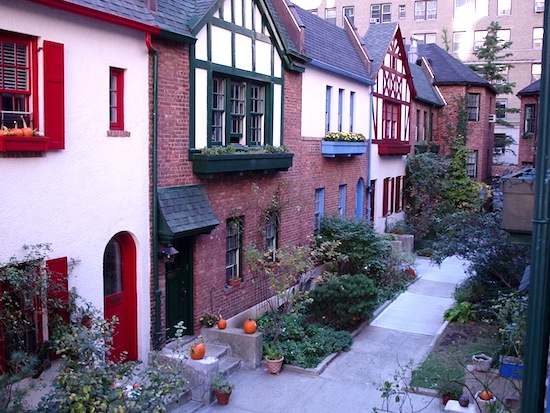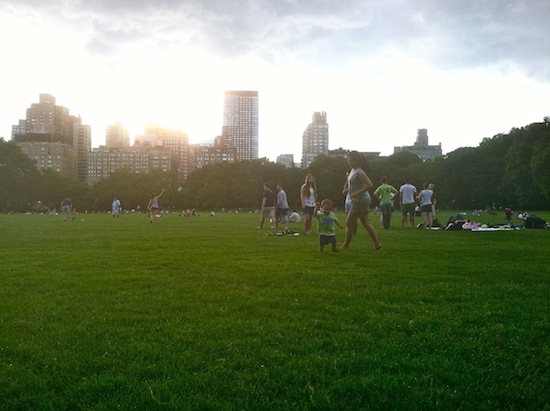What’s the quickest way to get to an English country village? Take the 1, 2 or 3 train to West 96th Street. Exit the train, walk west for half a block on 95th Street, and there it is — Pomander Walk, one of New York City’s best kept secrets. It’s hard to believe that here, in the shadow of Upper West Side high-rises, you’re looking at a picture-perfect courtyard built in 1921, a walkway lined with eight attached Tudor-style houses on either side that looks exactly as it did almost 100 years ago.
Thomas Healy, an Irish immigrant who made his fortune as a restaurant owner at the turn of the century, purchased the land where the Walk was built in 1920. Healy loved the theater (many of the best known actors and actresses of the time were patrons of his restaurants) so when he commissioned the architects Shiras Campbell and Beverly King to build a residential enclave on his land, he asked them to replicate the country village look of the stage sets from the play “Pomander Walk” that had came to Broadway in 1911 after a successful run in London. The architects used the sets as an inspiration but altered the original Georgian design to look more Tudoresque.
It has been speculated that Healy built Pomander Walk to be especially attractive to visiting actors and actresses—as “light housekeeping” apartments (read no maids rooms) that would be perfect for performers living in New York for a six month to one-year run of their play. Whether or not it was his intention, Pomander Walk did become a magnet for theater folks. Although it’s been reported but not confirmed that Humphrey Bogart, Lillian Gish and Margaret Hamilton all lived there, it is absolutely certain that Rosalind Russell, Paulette Goddard and Nancy Carroll did.
Once inside the locked wrought iron gates that lead to the walk, a visitor encounters 16 two-story houses built of brick, stucco and wood, each with a different facade. Trimmed in bright reds and greens and blues, some feature window boxes, others shutters; each has a two-step stoop and a postage-stamp garden in front. The houses were originally built with separate two-bedroom apartments up and downstairs but a few buyers have purchased both apartments and combined them to make a single-family home. What began as a rental property has been a co-op since 1984.
 The houses are small, each floor approximately 700 square feet and have been described in real-estate speak as diminutive, dainty, intimate and miniature.
The houses are small, each floor approximately 700 square feet and have been described in real-estate speak as diminutive, dainty, intimate and miniature.
What’s it like to live in a place as rarefied as Pomander Walk? “Pretty fabulous,” according to Clarissa Wilder Rousson, who lived there for 10 years while she worked and went to graduate school. “I’d walk through the gate and all of the stress of the day would fall away. Where else in the city can you sit on the stoop in front of your house with a cup of coffee and wearing pajamas?”
Bram Lewis who has lived on the Walk since 1974 and helped make sure it was designated as a landmark by the Landmarks Preservation Commission in 1982, describes it as “a special place. The neighbors have lots of impromptu get-togethers and each year we gather to celebrate Bastille Day and Halloween when we have a chili cook-off.”
Want to live on Pomander Walk?
You’re in luck: A two-bedroom, 750-square foot apartment is now available at #20 Pomander Walk, on the second floor. The broker with an exclusive on the apartment which is listed for $699,900, is Peter Segalla of Better Homes and Gardens/Rand Realty in Yonkers. Check out a typical floor plan here.
A version of this piece ran in am New York.
Marjorie Cohen is a West Side Rag columnist.
Photos courtesy of Peter Segalla.










Pomander Walk never fails to enchant! The architecture firm responsible for its restoration was recently honored at our 2011 awards ceremony, and may soon be featured in the international press. Check it out! https://bit.ly/lgL93T
Oh if only.